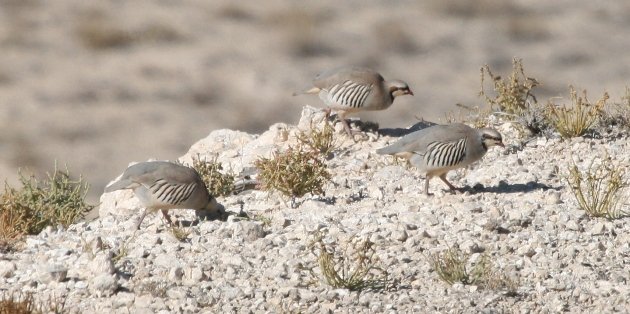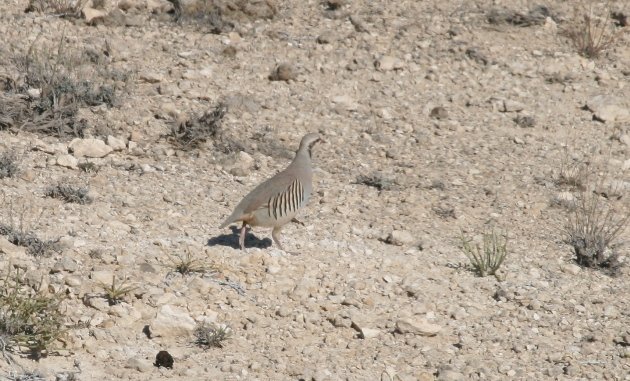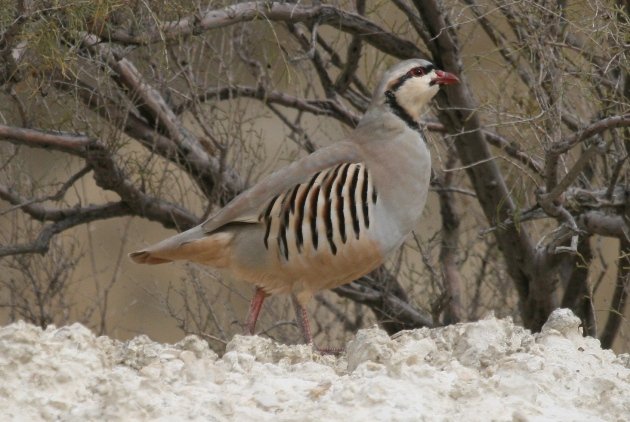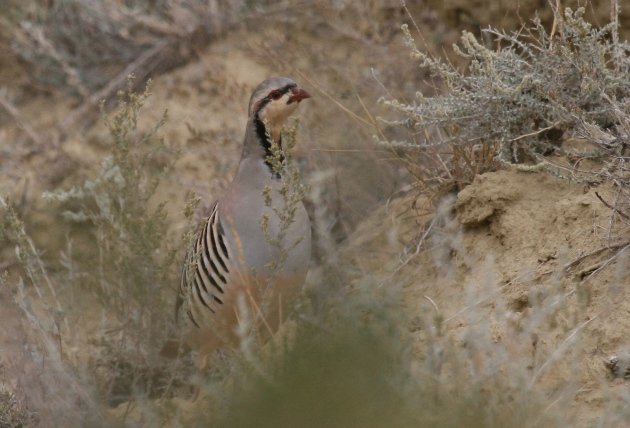
The Chukar is the most widely distributed and the most numerous of all the partridges that scientists assigned to the genus Alectoris. All these factors combined make for a great bird. Its range is not difficult for an Old World birder to visit, and once there the bird is not hard to find – for a partridge. Then there is the fact that its plumage (the original to the copy-cat New World quails) can easily rival many a spring’s warbler, and there you have it: just look up “marvelous” on wikipedia and the first thing you see is a full-sized image of a Chukar grinning at you. Oh, in case you do, you know, look up “marvelous” on wikipedia and can’t find a picture of a Chukar: it was recently edited away on the grounds that birds can’t grin.
Then of course, Chukars have style as they’ve chosen landscapes like this for them to roam…
Kazakhstan’s Mangghystau province. If your place doesn’t look anything like this, then you shouldn’t be seeing Chukars!
And the caption of the picture above is the point of this post: sometimes the choice of where to roam isn’t theirs. Indeed, the Chukar was and is being widely introduced to many parts of North America (not necessarily always for birding purposes), where it is regularly found out West but pops up here and there in the East as well.
Chukars of North America can tell you a lot about the mind-set of birders roaming that particular continent. Because birders like Chukars. They don’t like House Sparrows and they sure feel no sympathy whatsoever for Starlings. But Chukars are okay. You may argue that they don’t wreak the same havoc with the indigenous species as do the two aforementioned invasives, but that would be a rather avicentric view. If you were a botanist, or a seeding tuft of grass out West, you’d certainly disapprove.
Seed eaters looking for the next kill.
Willets used to nest here. Then came the Chukars.
So, where is the difference between a flock of Chukars and a flock of Starlings to the heart of a North American birder? Well, I can only guess (and you can decide whether that’s because I am not North American or don’t have a heart), but in my opinion, it’s all in the Chukar’s numbers: it is an ABA Code 2. This means it is not that easy to see, as in “more difficult than looking out of you kitchen window” as is the case for Starlings and House Sparrows. I’ve even met birders who went somewhere especially to see Chukars, and have yet to meet anyone who did the same for House Sparrows. In particular, I remember this one Chukar situation down South in Tennessee* a while ago. I stood there at the edge of a green meadow, looked at the bird and thought to myself that Tennessee was not in Asia, and that a lush green meadow was not within what the Chukar’s normal ecological parameter’s range should be, and that this was indeed a sorry sight to see. Then this car pulled up, a birder jumped out, ran towards me and called:
Pardon me, boy
Is that the Chattanooga Chukar?
An ABA Code 2
Boy can I look at it, too?
I can’t afford
To miss the Chattanooga Chukar
I’m doin’ a big year
With not a species to spare
I left my Pennsylvania home ’bout a quarter to four
Checked my BirdAlird when I was in Baltimore
Tell me where the bird is
Nothing is of more bliss
Than to tick if off and have it on my year list
And I said:
When you see the mistle growing left from the barn
Then you know the Chukar’s perch is not very far
This is where you should be
looking at the pear tree
Wooo, wooo, Chatta’ Chukar there you are!
There’s gonna be
A party at the observation
High Fives and cheers
A lifer dance and some beers
I’m gonna cry
Until I yell that it should not here roam!
So Chattanooga Chukar
won’t you shoo-shoo back home?
Chattanooga Chukar
won’t you shoo-shoo back home?
.
* I might have never been to Tennessee and might or might not have made this up for the sake of a story to tell.




















“I’ve even met birders who went somewhere especially to see Chukars, and have yet to meet anyone who did the same for House Sparrows.”
Guilty as charged. County birding, particularly rural county birding, does strange things to birders.
Have always loved that song, but didn’t know those verses. Well done! Great photos, too. I was surprised to see a lovely Chukar once on the Big Island of Hawaii.
I live in WNC at about 3400 ft elevation. Our neighbor has free roaming chickens, that roam our property. He called and said he sees a bird he hadn’t seen in NC. It wandered down to stare at us on our porch. It was a Chukar. We tried to feed it wild birdfood, but it did not eat. Finally wandering over to the creek and we never saw it again.
I recall thinking the beak was more pronounced than the photos above. Chunkier??
Thanks
Forgot to say this happened 2 years ago during the summer.
This kills me, Jochen. Epic!
When the 10,000 Birds call to action is “that you really need to read” I read. I love it! You even committed to the entire song too – hysterical! Someone once told me that you should never let the truth stand in the way of a good story; no issues here with that. Thank you Jochen.
I’m just glad that someone pays attention to what we say on Facebook!